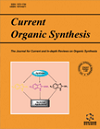- Home
- A-Z Publications
- Current Organic Synthesis
- Previous Issues
- Volume 21, Issue 4, 2024
Current Organic Synthesis - Volume 21, Issue 4, 2024
Volume 21, Issue 4, 2024
-
-
Beyond 1,2,3-triazoles: Formation and Applications of Ketemines Derived from Copper Catalyzed Azide Alkyne Cycloaddition
More LessKetemines represent an interesting class of organic intermediates that has undergone a regrowth as a consequence of recent extensions of copper catalyzed azide alkyne cycloaddition (Cu- AAC) to other synthetic fields. This review summarizes the most recent generation methods of ketimines from CuAAC reaction, highlighting chemical properties focused on the synthesis of cyclic compounds, among others, affording a general Read More
-
-
-
Green Approach Toward Triazole Forming Reactions for Developing Anticancer Drugs
More LessCompounds containing triazole have many significant applications in the dye and ink industry, corrosion inhibitors, polymers, and pharmaceutical industries. These compounds possess many antimicrobial, antioxidant, anticancer, antiviral, anti-HIV, antitubercular, and anticancer activities. Several synthetic methods have been reported for reducing time, minimizing synthetic steps, and utilizing less hazardous and toxic solve Read More
-
-
-
Pyrene Appendant Triazole-based Chemosensors for Sensing Applications
More LessOver the last two decades, the design and development of fluorescent chemosensors for the targeted detection of Heavy Transition-metal (HTM) ions, anions, and biological analytes, have drawn much interest. Since the introduction of click chemistry in 2001, triazole moieties have become an increasingly prominent theme in chemosensors. Triazoles generated via click reactions are crucial for sensing various ions and biological Read More
-
-
-
Triazole-linked Nucleic Acids: Synthesis, Therapeutics and Synthetic Biology Applications
More LessAuthors: Vivek K. Sharma, Priyanka Mangla, Sunil K. Singh and Ashok K. PrasadThis article covers the triazole-linked nucleic acids where the triazole linkage (TL) replaces the natural phosphate backbone. The replacement is done at either a few selected linkages or all the phosphate linkages. Two triazole linkages, the four-atom TL1 and the six-atom TL2, have been discussed in detail. These triazole-modified oligonucleotides have found a wide range of applications, from therapeutics to synthetic biol Read More
-
-
-
Emerging Aspects of Triazole in Organic Synthesis: Exploring its Potential as a Gelator
More LessAuthors: Rabecca J. Vasanthan, Sheersha Pradhan and Mohan Das ThangamuthuCu(I)-catalyzed azide−alkyne 1,3-dipolar cycloaddition (CuAAC) - commonly known as the “click reaction” - serves as the most effective and highly reliable tool for facile construction of simple to complex designs at the molecular level. It relates to the formation of carbon heteroatomic systems by joining or clicking small molecular pieces together with the help of various organic reactions such as cycloaddition, conjugate addition Read More
-
-
-
Recent Progress on Synthesis of Functionalized 1,5-Disubstituted Triazoles
More LessAuthors: Manoj K. Jaiswal, Abhishek Gupta, Faisal J. Ansari, Vinay K. Pandey and Vinod K. TiwariImmediately after the invention of ‘Click Chemistry’ in 2002, the regioselective 1,2,3- triazole scaffolds resulted from respective organic azides and terminal alkynes under Cu(I) catalysis have been well recognized as the functional heterocyclic core at the centre of modern organic chemistry, medicinal chemistry, and material sciences. This CuAAC reaction has several notable features including excellent regioselectivity, high-t Read More
-
-
-
Synthesis of Novel Fluoro Phenyl Triazoles Via Click Chemistry with or without Microwave Irradiation and their Evaluation as Anti-proliferative Agents in SiHa Cells
More LessAims: Perform the synthesis of novel fluoro phenyl triazoles via click chemistry with or without microwave irradiation and their evaluation as anti-proliferative agents in SiHa cells. Background: Triazoles are heterocyclic compounds containing a five-member ring with two carbon and three nitrogen atoms. They are of great importance since many of them have shown to have biological activity as antifungal, antiviral, antibac Read More
-
-
-
Heteroaromatization of Coumarin Part I: Design, Synthesis, Reactions, Antitumor Activities of Novel Pyridine and Naphthyridine Derivatives
More LessAuthors: Rita Mohammed Ahmed Borik and Ashraf Hassan F. A. El-WahabIntroduction: A novel series of chromen-3-yl-pyridine moieties were synthesized. IR, NMR, and MS spectroscopy were used to confirm the structure of these novel compounds and study antitumor activity of these compounds. The structure-activity relationship investigation demonstrated that 2,4-diamino- 5-(3-methoxyphenyl)-7-(2-oxo-2H-chromen-3-yl)-1,8-naphthyridine-3-carbonitrile (16), naphthyridine- 3-carbonitrile derivatives Read More
-
Volumes & issues
-
Volume 22 (2025)
-
Volume 21 (2024)
-
Volume 20 (2023)
-
Volume 19 (2022)
-
Volume 18 (2021)
-
Volume 17 (2020)
-
Volume 16 (2019)
-
Volume 15 (2018)
-
Volume 14 (2017)
-
Volume 13 (2016)
-
Volume 12 (2015)
-
Volume 11 (2014)
-
Volume 10 (2013)
-
Volume 9 (2012)
-
Volume 8 (2011)
-
Volume 7 (2010)
-
Volume 6 (2009)
-
Volume 5 (2008)
-
Volume 4 (2007)
-
Volume 3 (2006)
-
Volume 2 (2005)
-
Volume 1 (2004)
Most Read This Month
Article
content/journals/cos
Journal
10
5
false
en


